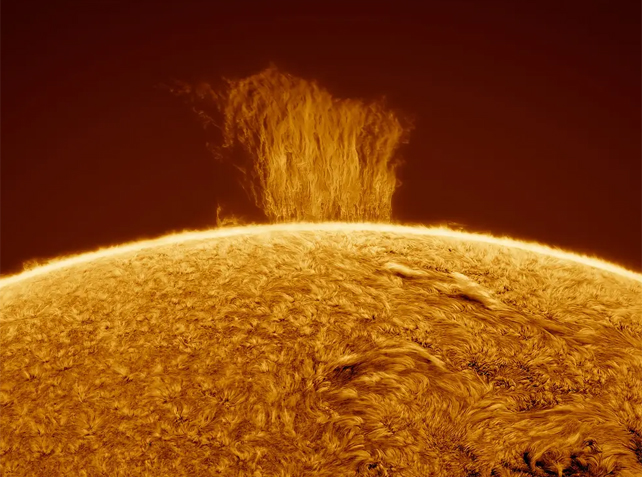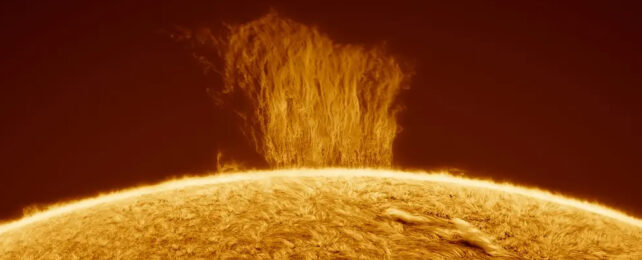A stunning solar "waterfall" has been spotted on the surface of the sun.
The picture, taken by astrophotographer Eduardo Schaberger Poupeau on March 9, shows a wall of plasma being shot "some 100,000 kilometers" – or about 62,000 miles – up towards space, Poupeau told Spaceweather.com.
That's high enough to engulf about eight Earths.
The plasma then seems to be cascading back down to the sun, giving the structure its "waterfall" nickname.
"On my computer screen, it looked like hundreds of threads of plasma were dripping down a wall. It really was a spectacle that left me speechless," Poupeau told the publication.
Scientists estimate that the plasma is falling back down at tremendous speeds – up to 22,370 mph per Space.com.
These plasma waterfalls are the solar equivalent to Earth's auroras
This structure is what is called a polar crown prominence.
Prominences on the sun usually take the form of giant tentacles of hot plasma, stretching out towards space in a big arc, as can be seen below.
But when these prominences happen near the poles of the sun, more specifically around the polar circle, the magnetic fields are so strong that instead of bursting towards space, the plasma can cascade back down to the sun very quickly.

Because of the location of these prominences, NASA likens them to aurora, because they circle the poles at about 60 to 70 degrees of latitude on the sun.
"Instead of Northern Lights, however, the sun's ovals are filled with dancing sheets of plasma," per a NASA blog post.
You can see these structures lining up around the polar circle below.
The sun is nearing a peak of activity
This is just the latest of a string of brilliant solar events that have happened in recent months as our sun nears a peak of activity.
About every decade, the sun's magnetic poles flip, which causes havoc with local magnetic fields that are bursting all over our star. In that period, remarkable solar events are more likely to happen.
Examples of recent solar events include:
- A plasma vortex swirling like a whirlpool around the solar pole.
- A massive coronal "hole" in our sun that spewed energy towards the Earth in recent weeks.
- Auroras spotted as far down as New Mexico.
- A solar "tornado" the size of 14 Earths that appeared when a prominence got caught in between magnetic fields.
Space weather is not just pretty
Scientists don't only look to the sun to see these beautiful structures. With solar events comes space weather, which can be damaging to our planet.
Any of these big solar events can release waves of energy that hurtle from the sun into space. If they are pointed at the Earth, these so-called solar storms could be damaging to power grids and other infrastructure if not managed properly, scientists previously told Insider.
This article was originally published by Business Insider.
More from Business Insider: